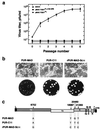Engineering the largest RNA virus genome as an infectious bacterial artificial chromosome
- PMID: 10805807
- PMCID: PMC25860
- DOI: 10.1073/pnas.97.10.5516
Engineering the largest RNA virus genome as an infectious bacterial artificial chromosome
Abstract
The construction of cDNA clones encoding large-size RNA molecules of biological interest, like coronavirus genomes, which are among the largest mature RNA molecules known to biology, has been hampered by the instability of those cDNAs in bacteria. Herein, we show that the application of two strategies, cloning of the cDNAs into a bacterial artificial chromosome and nuclear expression of RNAs that are typically produced within the cytoplasm, is useful for the engineering of large RNA molecules. A cDNA encoding an infectious coronavirus RNA genome has been cloned as a bacterial artificial chromosome. The rescued coronavirus conserved all of the genetic markers introduced throughout the sequence and showed a standard mRNA pattern and the antigenic characteristics expected for the synthetic virus. The cDNA was transcribed within the nucleus, and the RNA translocated to the cytoplasm. Interestingly, the recovered virus had essentially the same sequence as the original one, and no splicing was observed. The cDNA was derived from an attenuated isolate that replicates exclusively in the respiratory tract of swine. During the engineering of the infectious cDNA, the spike gene of the virus was replaced by the spike gene of an enteric isolate. The synthetic virus replicated abundantly in the enteric tract and was fully virulent, demonstrating that the tropism and virulence of the recovered coronavirus can be modified. This demonstration opens up the possibility of employing this infectious cDNA as a vector for vaccine development in human, porcine, canine, and feline species susceptible to group 1 coronaviruses.
Figures




Comment in
-
The making of infectious viral RNA: No size limit in sight.Proc Natl Acad Sci U S A. 2000 May 9;97(10):5025-7. doi: 10.1073/pnas.97.10.5025. Proc Natl Acad Sci U S A. 2000. PMID: 10805763 Free PMC article. Review. No abstract available.
References
-
- Enjuanes L, Brian D, Cavanagh D, Holmes K, Lai M M C, Laude H, Masters P, Rottier P, Siddell S G, Spaan W J M, et al. In: Virus Taxonomy. van Regenmortel M H V, Fauquet C M, Bishop D H L, Carsten E B, Estes M K, Lemon S M, Mayo M A, McGeoch D J, Pringle C R, Wickner R B, editors. New York: Academic; 1999. pp. 835–849.
Publication types
MeSH terms
Substances
Associated data
- Actions
LinkOut - more resources
Full Text Sources
Other Literature Sources

